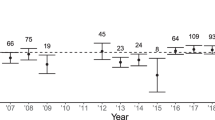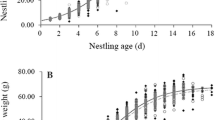Abstract
In the cooperatively breeding apostlebird (Struthidea cinerea, Corcoracidae) both sexes are philopatric and help to raise offspring. However, male helpers provision nestlings more often than females, an activity associated with reduced nestling starvation and enhanced fledgling production. Presuming that males are the more helpful sex, we examined the helper repayment hypothesis by testing the predictions that offspring sex ratio should be skewed toward the production of males (a) among breeding groups with relatively few helpers, and (b) in the population as a whole. The relationship between sex and hatching order was examined as a potential mechanism of biasing sex allocation. The sex ratio of all sexed offspring was male biased (57.9%; n = 171) as was the mean brood sex ratio (0.579; n = 70 broods). These biases were less pronounced in the subset of clutches/broods in which all offspring were sexed. This overall bias appeared to result from two distinct patterns of skew in the hatching order. First, mothers in small breeding groups produced significantly more males among the first-hatching pair. This is consistent with the helper repayment hypothesis given that later hatching chicks were less likely to survive, particularly in small groups. Second, almost all fourth-hatching chicks, usually the last in the brood, were male (91.7%, n = 12). This bias is difficult to interpret but demonstrates the value of examining hatching sequences when evaluating specific predictions of sex allocation theory in birds.


Similar content being viewed by others
References
Arnold KE, Griffith SC, Goldizen AW (2001) Sex-biased hatching sequences in the cooperatively breeding Noisy Miner. J Avian Biol 55:219–223
Badyaev AV, Hill GE, Beck ML, Dervan AA, Duckworth RA, McGraw KJ, Nolan PM, Whittingham LA (2002) Sex-biased hatching order and adaptive population divergence in a passerine bird. Science 295:316–318
Bednarz JC, Hayden TJ (1991) Skewed brood sex ratio and sex-biased hatching in Harris’s hawks. Am Nat 137:116–132
Boland CRJ, Heinsohn R, Cockburn A (1997) Experimental manipulation of brood reduction and parental care in cooperatively breeding white-winged choughs. J Anim Ecol 66:683–691
Brown JL (1987) Helping and communal breeding in birds: ecology and evolution. Princeton University Press, Princeton
Bruford MW, Hanotte O, Brookfield JFY, Burle T (1992) Single locus and multi-locus fingerprinting. In: Hoelzel AR (ed) Molecular genetic analysis of populations–a molecular approach. IRL Press, Oxford, pp 227–229
Chapman G (1998) The social life of the Apostlebird Struthidea cinerea. Emu 98:178–183
Cichoń M, Dubiec A, Stoczko M (2003) Laying order and offspring sex in blue tits Parus caeruleus. J Avian Biol 34:355–359
Clark AB (1978) Sex ratio and local resource competition in a prosimian primate. Science 201:163–165
Clarke MF, Jones DA, Ewen JG, Robertson RJ, Griffiths R, Painter J, Boag PT, Crozier R (2002) Male-biased sex ratios in broods of the cooperatively breeding bell miner Manorina melanophrys. J Avian Biol 33:71–76
Cockburn A (1998) Evolution of helping behavior in cooperatively breeding birds. Annu Rev Ecol Syst 29:141–177
Doutrelant C, Covas R, Caizergues A, du Plessis M (2004) Unexpected sex ratio adjustment in a colonial cooperative bird: pairs with helpers produce more of the helping sex whereas pairs without helpers do not. Behav Ecol Sociobiol 56:149–154
Ekman J, Dickinson JL, Hatchwell BJ, Griesser M (2004) Delayed dispersal. In: Koenig WD, Dickinson JL (eds) Ecology and evolution of cooperative breeding in birds. Cambridge University Press, Cambridge, pp 35–47
Emlen ST, Emlen JM, Levin SA (1986) Sex-ratio selection in species with helpers-at-the-nest. Am Nat 127:1–8
Emlen ST (1997) When mothers prefer daughters over sons. TREE 12:291–292
Ewen JG, Clarke RH, Moysey E, Boulton RL, Crozier RH, Clarke MF (2001) Primary sex ratio bias in an endangered cooperatively breeding bird, the black-eared miner, and its implications for conservation. Biol Conserv 101:137–145
Fisher RA (1930) The genetical theory of natural selection. Clarendon Press, Oxford
Frank SA (1990) Sex allocation theory for birds and mammals. Annu Rev Ecol Syst 21:13–55
Fridolfsson A-K, Ellegren H (1999) A simple and universal method for molecular sexing of non-ratite birds. J Avian Biol 30:116–121
Gowaty PA, Lennartz MR (1985) Sex ratios of nestling and fledgling Red-cockaded Woodpeckers (Picoides borealis) favor males. Am Nat 126:347–353
Griffin AS, Sheldon BC, West SA (2005) Cooperative breeders adjust offspring sex ratios to produce helpful helpers. Am Nat 166:628–632
Hamilton WD (1967) Extraordinary sex ratios. Science 156:477–488
Heinsohn RG (1992) Cooperative enhancement of reproductive success in white-winged choughs. Evol Ecol 6:97–114
Heinsohn RG (1995) Hatching asynchrony and brood reduction in cooperatively breeding white-winged choughs Corcorax melanorhamphos. Emu 95:252–258
Kilner R (1998) Primary and secondary sex ratio manipulation by zebra finches. Anim Behav 56:155–164
Koenig WD, Walters JR (1999) Sex-ratio selection in species with helpers at the nest: the helper repayment model revisited. Am Nat 153:124–130
Koenig WD, Stanback MT, Haydock J, Kraaijeveld-Smit F (2001) Nestling sex ratio variation in the cooperatively breeding acorn woodpecker (Melanerpes formicivorus). Behav Ecol Sociobiol 49:357–365
Komdeur J (2004) Sex-ratio manipulation. In: Koenig WD, Dickinson JL (eds) Ecology and evolution of cooperative breeding in birds. Cambridge University Press, Cambridge, pp 102–116
Komdeur J, Daan S, Tinbergen J, Mateman C (1997) Extreme adaptive modification in sex ratio of the Seychelles warbler’s eggs. Nature 385:522–525
Komdeur J, Magrath MJL, Krackow S (2002) Pre-ovulation control of hatchling sex ratio in the Seychelles warbler. Proc R Soc London B 269:1067–1072
Krackow S, Tkadlec E (2001) Analysis of brood sex ratios: implications of offspring clustering. Behav Ecol Sociobiol 50:293–301
Krebs EA, Green DJ, Double MC, Griffiths R (2002) Laying date and laying sequence influence the sex ratio of crimson rosella broods. Behav Ecol Sociobiol 51:447–454
Lack D (1968) Ecological Adaptations for Breeding in Birds. Methuen, London
Legge S, Heinsohn R, Double MC, Griffiths R, Cockburn A (2001) Complex sex allocation in the laughing kookaburra. Behav Ecol 12:524–533
Lessells CM, Avery MI (1987) Sex-ratio selection in species with helpers at the nest: some extensions of the repayment model. Am Nat 129:610–620
Ligon JD, Ligon SH (1990) Female-biased sex ratio at hatching in the green woodhoopoe. Auk 107:765–771
Nager RG, Monaghan P, Griffiths R, Houston DC, Dawson R (1999) Experimental demonstration that offspring sex ratio varies with maternal condition. Proc Nat Acad Sci USA 96:570–573
Pen IR, Weissing FJ (2000) Sex ratio optimization with helpers at the nest. Proc R Soc Lond B 267:539–544
Pike TW, Petrie M (2003) Potential mechanisms of avian sex manipulation. Biol Rev 78:553–574
Rasbash J, Browne W, Goldstein H, Yang M, Plewis I, Healy M, Woodhouse G, Draper D, Langford I, Lewis T (2000) A user’s guide to MlwiN. 2nd. Institute of Education, London
Stacey PB, Koenig WD (eds) (1990) Cooperative breeding in birds: long-term studies of ecology and behavior. Cambridge University Press, Cambridge
Stamps JA (1990) When should parents differentially provision sons and daughters? Am Nat 135:671–685
Stoleson SH, Beissinger SR (1995) Hatching asynchrony and the onset of incubation in birds, revisited. When is the critical period? Curr Ornithol 12:191–270
Trivers RL, Willard DE (1973) Natural selection of parental ability to vary the sex ratio of offspring. Science 179:90–92
Walters JR (1990) Red-cockaded Woodpeckers: a ‘primitive’ cooperative breeder. In: Stacey PB, Koenig WD (eds) Cooperative breeding in birds: long-term studies of ecology and behavior. Cambridge University Press, Cambridge, pp 69–101
West SA, Sheldon BC (2002) Constraints in the evolution of sex ratio adjustment. Science 295:1685–1688
West SA, Shuker DM, Sheldon BC (2005) Sex-ratio adjustment when relatives interact: a test of constraints on adaptation. Evolution 59:1211–1228
Woxvold IA (2004) Breeding ecology and group dynamics of the apostlebird. Aus J Zool 52:561–581
Woxvold IA (2005) Social organisation, cooperative breeding and sex allocation in the Apostlebird Struthidea cinerea. Ph.D Thesis, University of Melbourne
Woxvold IA, Magrath MJL (2004) Predation events at an Apostlebird nest. Corella 28:22–23
Woxvold IA, Magrath MJL (2005) Helping enhances multiple components of reproductive success in the cooperatively breeding apostlebird. J Anim Ecol 74:1039–1050
Woxvold IA, Mulder RA, Maghrath MJL (2006) Contributions to care vary with age, sex, breeding status and group size in the cooperatively breeding apostlebird. Anim Behav 72:63–73
Acknowledgements
We are grateful to the Ryan family for accommodation and permission to work on their property. We would also like to thank Raoul Mulder and several anonymous referees for their valuable comments on the manuscript. The research was supported by grants from The Holsworth Wildlife Research Endowment, The Norman Wettenhall Foundation, Australian Geographic, The American Museum of Natural History, The Royal Zoological Society of NSW, and Birds Australia (VicGroup). IAW was supported by an Australian Research Council Large Grant awarded to Jan Komdeur, and a stipend from the Faculty of Science, University of Melbourne. Collection of field data was greatly assisted by Eron Chapman, Rebecca McIntosh, Emma and Helen Burdekin, Eric Woxvold, Bryony Anderson, Holly Dumble, Georgina Read, John Sandow, Mark Johnson, Andrew Barnes, Telford Scully, Sonia Orchard and Chris Jarvis. Capture, sampling and monitoring of apostlebirds was conducted under the authority of licences required by Australian law.
Author information
Authors and Affiliations
Corresponding author
Rights and permissions
About this article
Cite this article
Woxvold, I.A., Magrath, M.J.L. Sex-biases in the hatching sequence of cooperatively breeding apostlebirds Struthidea cinerea . Evol Ecol 22, 139–151 (2008). https://doi.org/10.1007/s10682-007-9163-y
Received:
Accepted:
Published:
Issue Date:
DOI: https://doi.org/10.1007/s10682-007-9163-y




